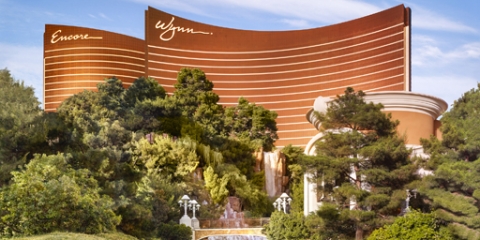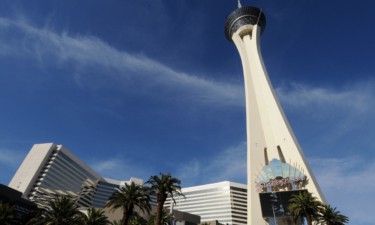
After a week of mostly shaky earnings reports, ‘business as usual’ from Wynn Resorts came as a benison to Wall Street. The company’s cash-flow results surpassed analyst expectations, by $17 million in Macao and by $7 million at Wynncore. “Overall, we found the commentary around both Macau, and, to a lesser extent, Las Vegas, to be constructive and favorable, despite tougher comparisons on the horizon in Las Vegas,” wrote a relieved Carlo Santarelli from Deutsche Bank. Wynn’s Macanese casinos delivered cash flow of $340 million, as they grew to 14% of market share. Hotel occupancy ran at 99% and Golden Week saw business improving still further.
With help from the Super Bowl and despite the absence of the CONAG conclave, Wynncore improved its cash flow 6%. Reported Santarelli, “It was a strange 1Q24 in Las Vegas, with non-gaming growth coming in at +16% Y/Y, while table game drop was up just 60 bps and slot handle fell 4.9% Y/Y … While the stagnation in gaming trends is worth monitoring, management noted that drop, handle, and RevPAR in Las Vegas were all up in April.” New renderings of Wynn Al-Marjan were also bandied about, with the $4 billion project still on budget. Elsewhere there was “excitement” about the tantalizingly delayed prospects in New York City (below) and “interest” in Thailand, though many moving parts there remain to come into focus.

Management went cheap on Encore Boston Harbor, scuttling a $400 million improvement due to a tax spat with the city fathers of Everett. The money instead will be spent on Wynncore, particularly on a rehab of the Encore tower. There’s also a food hall in Macao to be built and just getting underway. Santarelli was impressed … but not enough to move his price target above $132/share, although his rating remained “Buy.”
David Katz of Jefferies saw things slightly differently, writing that momentum in Macao was offsetting top-line weakness on the Las Vegas Strip. He stuck with a “Hold” rating and price target of $122/share. Joseph Greff of J.P. Morgan thought the numbers out of Wynncore “highlight its high-end positioning in LV, which in turn is allowing it to perform above its LV peers, particularly in non-gaming.” He continued, “Overall, we think investors should be pleased with these results … Management acknowledged that comparisons are getting more challenging but that market-wide attractions continue to boost demand.” His price target was also $122/share and his rating “Overweight.”

“Mixed results, poised for long term growth,” Katz wrote of Station Casinos. The company delivered $489 million in revenue where Wall Street had expected $492 million. Cash flow was off a hair, $209 million instead of The Street’s $210 million. Construction disruptions at Sunset Station dampened results slightly, as (more than slightly) did worse-than-expected gambling hold during the Super Bowl and March Madness. Katz reported that “Durango [Resort] operational performance continues to improve, attracting new consumers to the brand and increasing play from existing, and [leadership] remains confident the margin target and return goal will be achieved sooner than expected.” We don’t doubt them.
Durango Resort expansion and Inspirada are both “go” projects, as is the North Fork Rancheria tribal casino in California. At least $313 million will be spent on share buybacks and total leverage is coming down from 4.4X cash flow to something closer to 3X. Katz recommended a “Buy” on the stock, with a price target of $71/share.

Santarelli called the Station results “as expected.” Of the miss, he was relatively dismissive: “we struggle to imagine buyside forecasts were meaningfully north of Consensus, though the after-market stock action, albeit on limited volume, would say otherwise.” “Broadly uneventful” were his words for the earnings report, with a 20% ROI on Durango offsetting a 9% declivity elsewhere in the Station portfolio. As the analyst put it, “While [Station] properties do skew higher end, management did not note a distinction across the various assets, but we believe Durango is likely helping the aggregate, as it pertains to what management is seeing across the database.” Ominous noises, however, were made about “efficiency measures,” always a euphemism for job cuts. Like Katz, Santarelli rated Station a “Buy” albeit with a price target of $65/share.
Greff was the most clement of the three, saying the results were “in line” with expectations. Hey, what’s a couple of million among friends, really? (Station missed pretty marginally, unlike Boyd Gaming, which shook Wall Street’s confidence in the latter.) He noted that titular Red Rock Resort was suffering most from the Durango effect, something which that long-suffering property could do without. Station execs were quoted as saying “as we look ahead, we are seeing stability in the locals market and across our entire database … [the] low-end of the business, it’s actually up for the last two quarters in a row.” That’s cause for confidence, even if Greff was the most conservative in both is rating (Overweight) and price target ($62).

If Station knows where it is going, the same apparently can’t said for Golden Entertainment. Katz opined that the company was “Turning a page, but still searching for the next chapter.” Santarelli concurred: “Strategic direction the big question now.” The latter was the more confident, rating GDEN a “Buy” against Katz’s “Hold,” with a $36/share price target. “In our view, as it pertains to locals gaming and or lower end Strip trends, the bloom has been off the rose in Las Vegas for a bit now,” Santarelli wrote apropos Golden missing his cash-flow projection by $2 million. Company execs echoed Boyd ones, saying that promotional warfare was up and low-end business is down. Although “well positioned for nearly any strategic action scenario” with an enviable 2X debt-to-cash flow ratio, Golden isn’t inclined to take on new acquisitions, especially after the divestitures of 2023. It appears that the company will concentrate upon stock repurchases instead.
Katz noted, in Golden’s defense, that revenues came in a bit ahead of where The Street expected, despite the cash-flow miss. “More importantly, the sale of the last non-core asset was completed, allowing the company to reduce leverage and focus on capital returns and future M&A opportunities,” he added. The low-end softness was felt most at Arizona Charlie’s, which saw sharp declines of both revenue and cash flow. Mind you, Golden no longer has slot routes to offset the variability of the brick-and-mortar casino biz. At least the tavern business, Golden’s bread and butter, came in slightly ahead of where Katz thought it would be. In other good new, occupancy at The Strat rose notably, hitting 78%, while the opening of Atomic Golf was expected to add as much as $5 million in annual cash flow. As for taverns, Golden just bought two more, bringing its flotilla to 71, with a family of 160 hoped for by 2027. Fore!
We’ve been writing all week and are getting rather blurry (and we’re not done yet), so we’ll see you on the weekend with a special edition.

